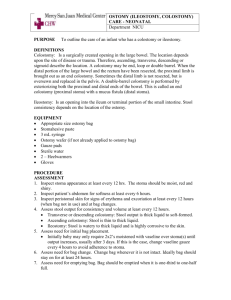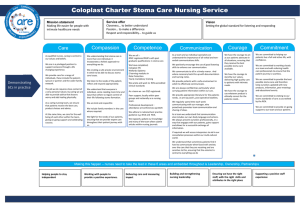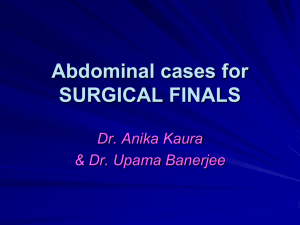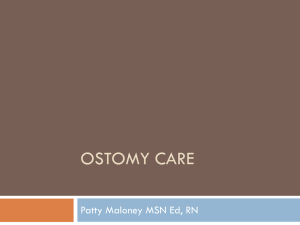History
advertisement
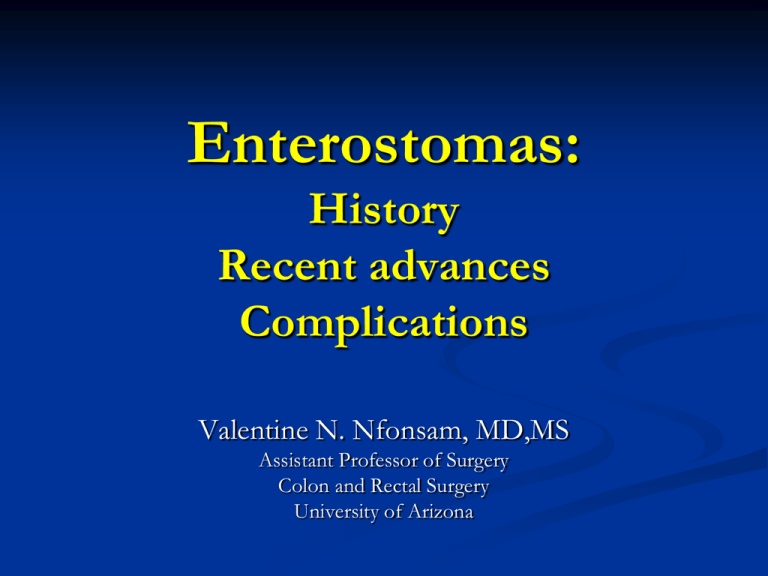
Enterostomas: History Recent advances Complications Valentine N. Nfonsam, MD,MS Assistant Professor of Surgery Colon and Rectal Surgery University of Arizona Introduction Over 500,000 in the US have some kind of functional enterostomy Annually 120,000 more are created 36.1% colostomy 32.2% ileostomy 31.7% urostomy Average age of a patient with ostomy is 68.3 years Advances in stoma surgery, enterostomal therapy and ostomy management led to better ostomates lives Colorectal surgeons have pioneered new techniques and ostomy management systems that have allowed the intestinal stoma to be a barely noticeable alternative to perianal defecation History •The Bible describes one of the earliest accounts of visceral injury in the old testament when Eglon was stabbed by Ethud: “He (Eglon) could not draw the dagger out of his belly and dirt came out” •350 BC – Praxagoras of Kos – has a kind of stoma created by intestinal injuries History Hippocrates(460-377BC), Cornelius (53BC-AD7), Galen(131-201AD) knew injuries to colon and small intestine were often fatal – but did not know what to do 14th Century: Artillery began to be used in wars, and patients with GSW to abdomen – mostly died Prior to WWI - French did pioneering work on stoma surgery – which later spread to the rest of Europe Between the Two world wars and after WWII – Americans took the lead in the field of stoma. History •Soldier George Deppe injured his back at the Battle of Ramillies (The duke of Marlborough beat the French) – May 23rd 1706. •He sustained a wound to the lower back – and developed what today is known as a fisula •He lived with it for 14 years. History Earliest stomas were not envisioned or created by imaginative surgeons but by forces of nature These patients managed these stomas on their own It was only much later that physicians ponder the surgical creation of an ostomy. In 1757 Lorenz Heister (1683-1758) first recommended the surgical creation of stomas for the treatment of abdominal trauma. History After observing spontaneous stomas in individuals with abdominal wounds, Heister wrote: "As the lips of the intestines, so wounded, would sometimes quite unexpectedly adhere to the wound of the abdomen; and therefore it seemed no reason why we should not take hints from nature" History Time of barber surgeons such as John Bell and Gene Palfin "It is surely far better to part with one of the conveniences of life than to part with life itself“ (Lorenz Heister) History In 1710 Alexis Littre (1626-1726) suggested the creation of an abdominal stoma in the treatment of imperforated anus after observations made during the autopsy of a six-day old infant. This idea remained untested for 66 yrs until in1777 when Pilore, a country surgeon from Rouen, France performed a cecostomy for the treatment of an obstructing rectal cancer. (histoire) “…..for a dressing, I applied burnt charcoal and towels.” History Not until 1793 that the first successful stoma was created. Duret, a naval surgeon at Brest performed the first successful left iliac colostomy in the treatment of imperforated anus on a three-day old infant. He practiced on a 15 day old dead child Pt. survived till age 45 History With the advent of surgical stomas, it became necessary to create a means for the collection of feces. Pts left to their own devices First mention of collecting device was reported by Daguesceau in 1795. He performed a left inguinal colostomy on a patient that impaled himself on a wheat cart The Farmer created his own appliance and died at age 81 “…he conveniently collected his feces in a small leather pouch” History Until this time only loop stomas had been surgically created Prone to prolapse and often did not completely divert the fecal stream. In 1881, Schitsinger and Madelung both described a procedure for creating a proximal “single barreled” stoma while returning the distal loop in to the abdominal cavity This was the start of the end colostomy History Stomas also played an important role in early techniques for safe intestinal anastomosis Primary anastomosis advocated in the late 1800s ---high morbidity and mortality Johann Von Mikulicz-Radecki noted high leak rates led to Morbidity and Mortality. He advocated a two-stage technique for intestinal anastomosis Resection with double-barreled stoma Anastomosis 2 weeks later Morality decreased from 50% to 12.5% in his first 100 pts. History Colostomy also become important in the treatment of other conditions like diverticular disease. In 1907 Mayo first described the use of the right transverse colostomy in the treatment of diverticulitis with reversal after resolution of inflammation In the 1930s, Mayo, Rankin and Braun independently described a three stage approach consisting of - diverting transverse colostostomy and drainage, - a secondary sigmoid resection with anastomosis and - finally a colostomy closure. Henry Hartmann (1860-1952) Born in France and graduated from the university of Paris Medical school in 1877 Performed more than 30,000 operations Somewhere between 1909 and 1923 devised the “Hartmann procedure” for obstructing sigmoid cancer. Unknown if he ever performed this for diverticulitis Unknown surgeon in the 1930s first performed this two-staged resection and anastomosis for diverticulitis History Though the first colostomy was performed in 1776, the first ileostomy was performed more than a century later. In 1879, Baum, in Germany, performed the first diverting ileostomy for treatment of obstructing right colon cancer In 1883 Maydl, of Vienna, performed the first successful ileostomy in combination with a colonic resection J. M. T. Finney described the flush-loop ileostomy for treatment of SBO- Much complications, skin irritation History In 1888, the support rod was introduced to prevent retraction of the loop stoma until it has granulated to the abdominal wall Major advancement. Produced protruding stoma. Provided almost complete diversion of fecal stream. Widespread use of Ileostomy came as a result of the work of John Y. brown, a St. Louis Surgeon in 1912. Reported experience with 10 pts Ileostomy at lower pole of laparotomy incision Stoma protruded 2-3 inches beyond abdominal wall and was emptied by a catheter sewn in place Catheter removed eventually and stoma matured by itself. History The single most important advance in ileostomy history was described by Bryan Brooke, university of Birmingham, London In a 1952 article, entitled “Management of Ileostomy and its Complications”, Brooke in a single sentence, dramatically advanced surgical treatment and life with an ileostomy. Bryan Brooke History ‘A more simple device is to evaginate the ileal end at the time of operation and suture the mucosa to the skin; no complications have occurred from this’ - Bryan Brooke (1952) History Crile in 1942 also suggested the "mucosal grafted ileostomy" to prevent ileostomy dysfunction. He recommended removing the distal 3 to 4 cm of serosa and muscle from the ileostomy and folding over and suturing the redundant mucosa to the abdominal skin in order to "mature" the ileostomy at the time of surgery. Dr George Crile – Co founder of Cleveland Clinic History Turnbull and Crile (Cleveland clinic) and Brooke made advances in ileostomy surgery Turnbull and Gill coined the term “enterostomal therapist” in 1958 Turnbull opened the first school of enterostomal therapy in 1961 First real pouch was created in 1944 by Henry Koenig (ileostomate) Rupert Turnbull History of Ileostomy Ileostomy – relatively newer terminology First recorded Ileostomy – 1879 by Wilhem Baum, a German Surgeon from Danzig – created a ileostomy in a patient with malignant tumor – Patient died 9 weeks later Successful recovery after ileostomy – reported by Maydi from Vienna in 1883 Lauenstein (1894) created the first protruding ileostoma. Wilhem Baum Types of Stomas Colostomy Ileostomy End colostomy Loop colostomy End Ileostomy Loop ileostomy End Loop ostomy Cecostomy Urostomy Types of Ostomy Stoma types End ostomy types (A) End stoma (inset shows everting maturation); (B) double-barrel stoma: End stoma and mucous hop-Koop stoma; and (F) fistula are divided and brought through the same incision (inset shows closed mucus fistula sutured to abdominal wall); (C) loop stoma; (D) decompressing blowhole stoma; (E) Bis Santulli stoma Indications To provide fecal diversion for both elective and emergent procedures Colonic obstruction Bowel perforation with peritonitis Trauma Protection of low colorectal/coloanal anastomosis Perianal sepsis Radiation proctitis Rectovaginal fistula incontinence Preoperative Considerations Preoperative Counseling Stoma nurse/therapist Assuage anxiety Explain post op care Stoma site selection Visibility (pt. able to care for stoma) Colostomy vs ileostomy Assess pt supine, sitting, standing and bending forward Individualized Pass through Rectus abdominis muscle ( parastomal hernia) Superior aspect of the infra-umbilical fat fold in the lower quadrant (pt. visibility) Obese pts –better located in upper abdomen Avoid skin creases, bony prominences, scars, drain sites and belt lines. Mark site Advances Improvement in Stoma creation – Laparoscopic / Single port techniques Placement of mesh at the time of ostomy construction Improvements in stoma appliances including Laparoscopic options Laparoscopic colostomy / Ileostomy 3 ports usually, SILS Operative time usually ~ <1 hour Lap Transverse Colostomy Advantages of Laparoscopy Better selection of stoma site – as no midline incision is involved Early post operative recovery Better pain control Short length of hospital stay Cosmesis Stoma and recreation Can swim – without harming the stoma /spillage. Bag and adhesive are waterproof. Mini bags , Stoma caps are available Diving: Yes. A suit including the bag would be better Sauna: Yes. Sauna belts are available Complications 20-41% of patients will have complications Nearly 50% of these will require a revision Ileostomy vs colostomy Early complications Ischemia, hemorrhage, stenosis, fistula and retraction. Technical Late complications 6% -76% incidence Prolapse, obstruction, hernia and skin irritation Complication due to poor technique and poor care and management. Could also be due to recurrent disease. Stoma Ischemia/Necrosis 2.3-17% incidence Ranges from harmless mucosal sloughing to frank Necrosis Causes Aggressive stripping of mesentery Stenotic fascia defect Extensive tension Assess depth of necrosis Necrosis beyond fascial defect warrants immediate reconstruction Consider End loop Hemorrhage Mild hemorrhage common and self limiting. Usually mucosal. Apply pressure Active bleeding Implies failure to ligate a mesenteric vessel Identify and ligate prior to leaving OR Stomal Stenosis/Stricture 2-14% incidence Could manifest early or late Ischemia is usual underlying factor Other causes: -Infection and retraction R/o Crohn’s or recurrent malignancy Treat initially with dilation Definitive Stoma revision Mucocutaneous Separation Separation along mucocutaneous border Occurs to some extent in many patient Caused by underlying tension and or separation of sutures Supportive care usually resolve problem Could lead to eventual stricture, serositis or infection Infection/Fistula Incidence of 2-14.8% Peristomal abscess infected hematoma Stoma revision Foliculitis for mature stomas I &D Fistula may form from Abscess Beyond immediate post op, fistula formation or infection could be signs of recurrent Crohn’s disease Stoma Retraction 1-6% for colostomy and 3-17% for ileostomy Most common reason for re-operation Tension: Tension Obesity Steroids use. Poor wound healing Can lead to leakage and severe skin problem, more in ileostomy Convex stoma plate or use of protective barrier helps Most eventually need revision Prolapse 2-26% incidence Seen mostly in transverse loop colostomy (30%) May occur with parastomal hernia Managed by reduction and supportive care until definitive surgery Convert to end colostomy if need be Ileostomy Prolapse Parastomal Hernia “ It doesn’t matter if God Himself made your ostomy. If you have it long enough you have a 100% risk of a parastomal hernia” J Byron Gathright, 1996 50% of patients Predisposing factors Stoma placement lateral to rectus Large stoma aperture Obesity Prior abdominal incisions Malnutrition Wound infection Minor cases- Abdominal binder Symptomatic – Repair with mesh, Relocation Acute Parastomal hernia/Bowel obstruction Incidence 4.6-13% in early post op Causes Technical Too large fascial defect Rarely seen in mature stomas Signs of bowel obstruction Repair hernia with mesh Skin Complication 3-42% Incidence Range from mild skin dermatitis to full- thicknes skin necrosis and ulceration More common with illeostomy Skin Erosion from constant exposure to stoma effluent Contact dermatitis Fungal infection Intervention Contact Dermatitis Better fitting appliance Improve cleaning of peristomal skin Application of desents and skin barriers Anti fungals and antibiotics Stoma paste Effluent Irritation Edema Skin Complications Candida albicans infection Foliculitis Skin Complication (Pyoderma Gangrenosum) First described associated with Crohn’s in 1970 Diagnosis mainly by physical exam (80%) “Cookie cutter” appearance Treatment conflicting Wound debridement Steroids injection Systemic therapy Skin Complications (Pyoderma Gangrenosum) Skin Complications (Granulomas) Granulomas are lumpy lesions due to inflammation in the dermis. Stomal granulomas may be due to: Granulation tissue (poor wound healing and infection) Bowel metaplasia (stomal skin morphing into bowel tissue) Crohn's disease Stoma warts Stoma Appliances Conclusion In the last century, there have been dramatic improvements in surgical techniques for the creation of stomas Life with a stoma has also changed dramatically The development of enterostomal therapy and the improvement of ostomy management systems have made life with a stoma nearly as routine as life with an anus. Conclusion “care and expertise are important in creating intestinal stomas because some patients must live with the technical result for the rest of their lives” Thank you
